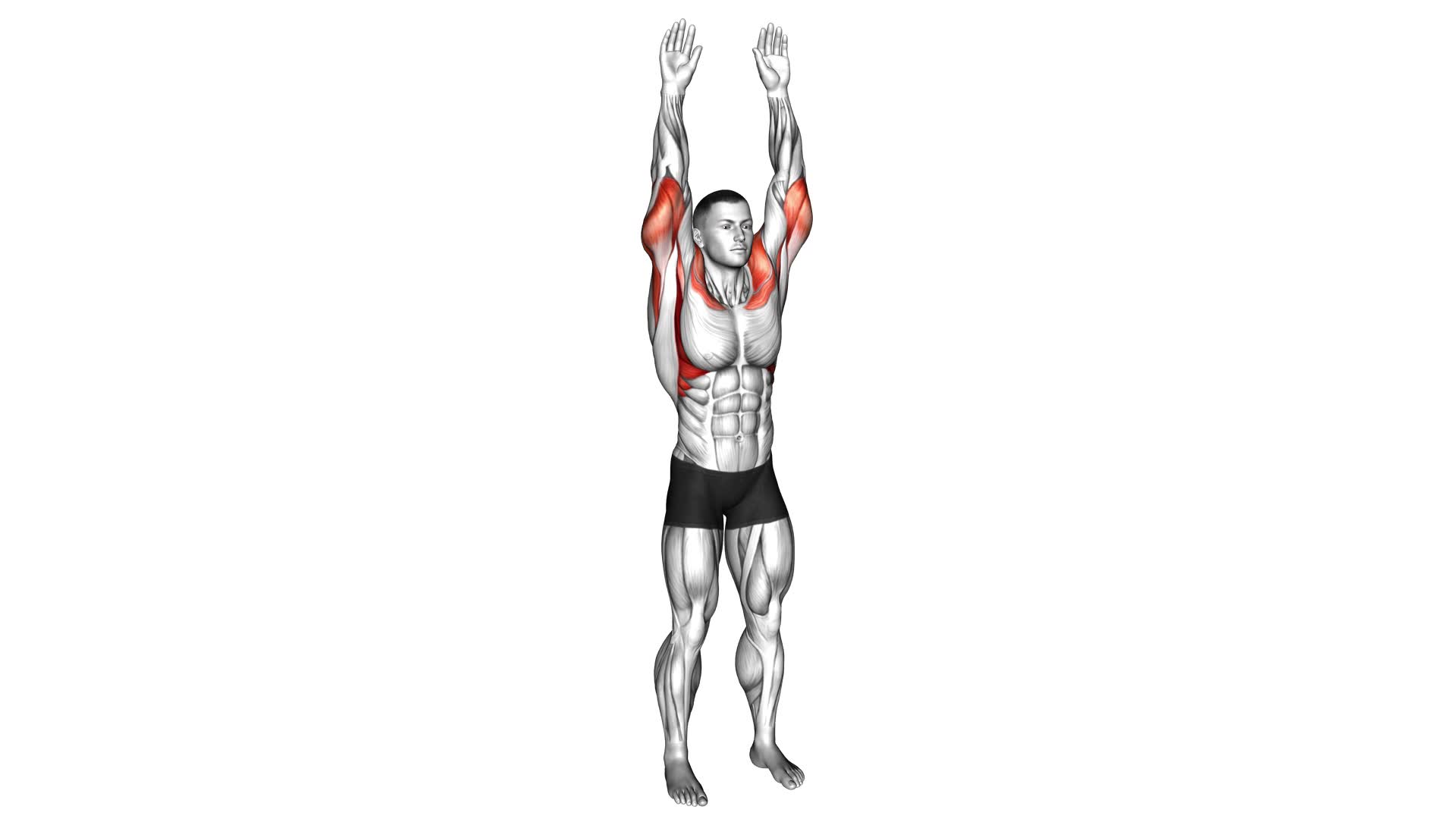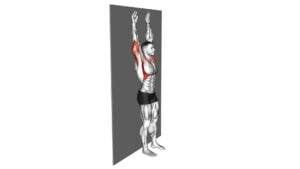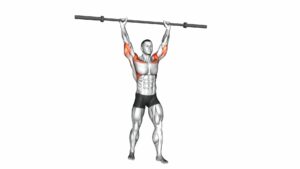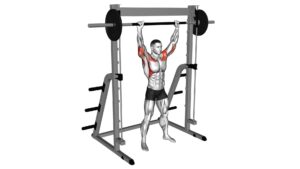Bodyweight Standing Military Press – Video Exercise Guide & Tips

Are you looking to strengthen your shoulders and arms?
Watch This Exercise Video
The Bodyweight Standing Military Press is the perfect exercise for you.
In this video exercise guide, we'll show you the proper form, common mistakes to avoid, and variations for all fitness levels.
Get ready to maximize shoulder and arm engagement and prevent injuries.
Let's get started!
Key Takeaways
- Engage your core muscles and maintain proper form throughout the exercise
- Use proper technique and avoid excessive arching of the lower back
- Focus on using your shoulder muscles instead of relying on momentum
- Gradually increase resistance to continue challenging your muscles
Proper Form for the Bodyweight Standing Military Press
To ensure proper form for the bodyweight standing military press, you should make sure that you maintain a stable and strong core throughout the exercise. This is crucial for maximizing the benefits of the exercise and preventing any potential injuries.
The standing military press is a highly effective exercise that targets your shoulders, triceps, and upper back muscles, helping you build strength and improve your overall upper body power.
One of the key benefits of the bodyweight standing military press is that it can be done without any equipment. All you need is your own bodyweight, making it a convenient exercise that can be performed anywhere, anytime. This eliminates the need for expensive gym memberships or bulky equipment, making it accessible to everyone. Additionally, the bodyweight standing military press engages your core muscles to stabilize your body throughout the movement, enhancing your balance and coordination.
To perform the exercise correctly, start by standing with your feet shoulder-width apart and your arms extended overhead, palms facing forward. Engage your core muscles by tightening your abs and glutes. Slowly lower your arms down towards your shoulders, keeping your elbows slightly in front of your body. Pause for a moment, then press your arms back up to the starting position, fully extending your elbows. Remember to exhale as you press up and inhale as you lower the weights.
Common Mistakes to Avoid During the Exercise
One common mistake to avoid during the bodyweight standing military press is allowing your lower back to arch excessively. Maintaining proper alignment is crucial to avoid injury and get the most out of this exercise. When your lower back arches too much, it puts excessive stress on your spine and can lead to lower back pain or injury. To avoid this, engage your core muscles and keep your pelvis tucked under throughout the movement. Imagine a straight line running from your head to your heels, and make sure to maintain that alignment.
Another mistake to watch out for is using momentum to lift the weight. This not only takes away from the effectiveness of the exercise but also increases the risk of injury. Instead, focus on using your shoulder muscles to lift the weight in a controlled manner. Keep the movement slow and controlled, and avoid using your legs or hips to generate momentum.
Lastly, make sure to fully extend your arms overhead at the top of the movement. Sometimes, people tend to stop short of full extension, which can limit the benefits of the exercise. By fully extending your arms, you engage your shoulder muscles more effectively and work on improving your range of motion.
Variations and Progressions for All Fitness Levels
For all fitness levels, there are various variations and progressions available for the bodyweight standing military press. Whether you're a beginner looking to build strength or an advanced lifter aiming to challenge yourself further, these modifications will help you tailor the exercise to your specific needs.
If you're new to the standing military press, you can start with the seated variation. This allows you to focus on proper form and build a solid foundation before progressing to the standing version. Another modification is to use dumbbells or resistance bands instead of your bodyweight. This provides additional resistance and allows for gradual progression as you get stronger.
For those who are more advanced, you can try the single-arm standing military press. This requires more stability and engages your core muscles to a greater extent. Additionally, you can incorporate a push press or a push jerk into your routine to add explosiveness and challenge your muscles in a different way.
By incorporating these progressions and modifications into your workout routine, you can continue to challenge yourself and make continuous gains in strength and muscle development.
Now that you're familiar with the variations and progressions for the bodyweight standing military press, let's move on to some tips for maximizing shoulder and arm engagement.
Tips for Maximizing Shoulder and Arm Engagement
How can you ensure maximum shoulder and arm engagement during the bodyweight standing military press? Here are three tips to help you maximize the benefits of this exercise and strengthen your shoulders and arms:
- Maintain proper form: Stand with your feet shoulder-width apart, keeping your core engaged and your back straight. As you press upward, make sure to fully extend your arms overhead and bring your head slightly forward to avoid straining your neck.
- Focus on the muscles: Throughout the movement, concentrate on contracting your shoulder and arm muscles. Visualize the muscles working and engage them consciously to maximize their activation.
- Gradually increase resistance: If you find the bodyweight standing military press becoming too easy, try adding resistance by using dumbbells or a weighted vest. This will challenge your muscles and help you continue to progress in your shoulder and arm strengthening journey.
By following these tips, you can ensure maximum engagement of your shoulders and arms during the bodyweight standing military press.
Now, let's move on to the next section and discuss key safety guidelines for injury prevention.
Key Safety Guidelines for Injury Prevention
Injury prevention is crucial when performing any exercise, including the bodyweight standing military press. By following proper technique and implementing key safety guidelines, you can minimize the risk of injury and maximize your results.
First and foremost, it's essential to maintain proper form throughout the exercise. This means keeping your core engaged, shoulders back and down, and neck aligned with your spine. Avoid arching your back or using excessive momentum, as this can put unnecessary strain on your spine and increase the risk of injury.
Additionally, it's important to start with an appropriate weight and gradually increase it as your strength improves. Using too much weight can lead to muscle imbalances and strain, while using too little weight may not provide enough resistance to effectively target your muscles.
Furthermore, always warm up before starting your workout. This helps increase blood flow to your muscles, preparing them for the demands of the exercise. Cooling down and stretching afterwards is equally important, as it helps prevent muscle tightness and aids in recovery.
Lastly, listen to your body and take breaks when needed. Pushing through pain or fatigue can lead to injuries, so it's important to rest and recover when necessary.
By following these safety guidelines and focusing on proper technique, you can minimize the risk of injury and achieve optimal results from your bodyweight standing military press.
Stay safe, stay motivated, and enjoy the benefits of this challenging exercise.
Frequently Asked Questions
What Are the Benefits of Incorporating Bodyweight Standing Military Press Into My Workout Routine?
Incorporating bodyweight standing military press into your workout routine has several benefits. It helps strengthen your shoulders, triceps, and upper back, improving overall upper body strength. This exercise also engages your core muscles, promoting stability and balance.
Performing it properly involves standing with your feet shoulder-width apart, lifting the barbell from shoulder height to fully extended arms, and then lowering it back down.
Including this exercise in your routine can lead to increased muscle definition and improved overall fitness.
Can I Do Bodyweight Standing Military Press if I Have a Shoulder Injury?
If you have a shoulder injury, it's important to modify your workout routine.
While bodyweight standing military press can be a great exercise, it may not be suitable for you at the moment.
Instead, focus on exercises that don't put too much strain on your shoulders, such as lateral raises or front raises.
These alternatives are beginner-friendly and will still target your shoulder muscles effectively.
Remember to listen to your body and consult with a healthcare professional if needed.
How Often Should I Include Bodyweight Standing Military Press in My Exercise Routine?
To maximize shoulder strength and get an effective upper body workout, it's recommended to include bodyweight standing military press in your exercise routine regularly. This exercise targets your shoulders, triceps, and upper back, helping to build overall upper body strength.
Aim for 2-3 times per week, allowing at least one day of rest in between sessions to give your muscles time to recover. Remember to start with proper form and gradually increase the intensity to avoid injury and achieve optimal results.
Keep pushing and watch your strength soar!
Are There Any Modifications or Alternatives for Beginners Who Find the Exercise Challenging?
If you're a beginner finding the bodyweight standing military press challenging, don't worry, there are alternative modifications and beginner-friendly variations you can try.
These modifications can help you build strength and improve your form gradually. By using resistance bands or starting with lighter weights, you can reduce the difficulty level.
Additionally, practicing with dumbbells or using a stability ball can also provide stability and support as you work your way up to the full exercise.
Keep pushing yourself and you'll progress in no time!
Can Bodyweight Standing Military Press Help Improve My Posture?
Bodyweight standing military press can definitely help improve your posture. By engaging your shoulders and core muscles, this exercise promotes proper alignment and stability.
It strengthens your shoulder muscles, helping to pull your shoulders back and counteract the effects of slouching. Additionally, the activation of your core muscles during the movement helps to support your spine and maintain a strong, upright posture.
Incorporating this exercise into your routine can have a positive impact on your overall posture and shoulder health.
Conclusion
In conclusion, the bodyweight standing military press is a challenging exercise that targets the shoulders and arms. By maintaining proper form, avoiding common mistakes, and incorporating variations and progressions, you can maximize your shoulder and arm engagement.
Remember to follow key safety guidelines to prevent injuries. Keep pushing yourself and stay consistent with your workouts to see progress and achieve your fitness goals.
Stay motivated and never give up!

Author
Years ago, the spark of my life’s passion ignited in my mind the moment I stepped into the local gym for the first time. The inaugural bead of perspiration, the initial endeavor, the very first surge of endorphins, and a sense of pride that washed over me post-workout marked the beginning of my deep-seated interest in strength sports, fitness, and sports nutrition. This very curiosity blossomed rapidly into a profound fascination, propelling me to earn a Master’s degree in Physical Education from the Academy of Physical Education in Krakow, followed by a Sports Manager diploma from the Jagiellonian University. My journey of growth led me to gain more specialized qualifications, such as being a certified personal trainer with a focus on sports dietetics, a lifeguard, and an instructor for wellness and corrective gymnastics. Theoretical knowledge paired seamlessly with practical experience, reinforcing my belief that the transformation of individuals under my guidance was also a reflection of my personal growth. This belief holds true even today. Each day, I strive to push the boundaries and explore new realms. These realms gently elevate me to greater heights. The unique combination of passion for my field and the continuous quest for growth fuels my drive to break new ground.







